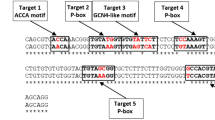Abstract
Eicosapentaenoic acid (EPA, 20:5n-3) plays an important role in many aspects of human health. In our efforts towards producing high levels of EPA in plants, we investigated the effects of different host species, genes and promoters on EPA biosynthesis. Zero-erucic acid Brassica carinata appeared to be an outstanding host species for EPA production, with EPA levels in transgenic seed of this line reaching up to 25%. Two novel genes, an 18-carbon ω3 desaturase (CpDesX) from Claviceps purpurea and a 20-carbon ω3 desaturase (Pir-ω3) from Pythium irregulare, proved to be very effective in increasing EPA levels in high-erucic acid B. carinata. The conlinin1 promoter from flax functioned reasonably well in B. carinata, and can serve as an alternative to the napin promoter from B. napus. In summary, the judicious selection of host species and promoters, together with the inclusion of genes that enhance the basic very long chain polyunsaturated fatty acid biosynthetic pathway, can greatly influence the production of EPA in plants.


Similar content being viewed by others
References
Abbadi A, Domergue F, Bauer J, Napier JA, Welti R, Zähringer U, Cirpus P, Heinz E (2004) Biosynthesis of very-long-chain polyunsaturated fatty acids in transgenic oilseeds: constraints on their accumulation. Plant Cell 16:1–15
Babic V, Datla RS, Scoles GJ, Keller WA (1998) Development of an efficient Agrobacterium-mediated transformation system for Brassica carinata. Plant Cell Rep 17:183–188
Bauer J, Wu G, Qiu X (2008) Isolation and characterization of a novel Pythium omega-3 desaturase with specificity to all omega-6 fatty acids longer than 18 carbon chains. WO/2008/022963
Hong HP, Datla N, Reed DW, Covello PS, MacKenzie SL, Qiu X (2002) High-level production of γ-linolenic acid in Brassica juncea using a Δ6 desaturase from Pythium irregulare. Plant Physiol 129:354–362
Kinney AJ, Cahoon EB, Damude HG, Hitz WD, Kolar CW, Liu ZB (2004) Production of very long chain polyunsaturated fatty acids in oilseed plants. Patent WO/2004/071467 A2
Kooter JM, Matzke MA, Meyer P (1999) Listening to the silent genes: transgene silencing, gene regulation and pathogen control. Trends in Plant Sci 4:340–347
Matzke AJM, Matzke MA (1998) Position effects and epigenetic silencing of plant transgenes. Curr Opin Plant Biol 1:142–148
Meesapyodsuk D, Reed DW, Covello PS, Qiu X (2007) Primary structure, regioselectivity, and evoloution of the membrane-bound fatty acid desaturases of Claviceps purpurea. J Biol Chem 282:20191–20199
Meyer A, Kirsch H, Domergue F, Abbadi A, Sperling P, Bauer J, Cirpus P, Zank TK, Moreau H, Roscoe TJ, Zähringer U, Heinz E (2004) Novel fatty acid elongases and their use for the reconstitution of docosahexaenoic acid biosynthesis. J Lipid Res 45:1899–1909
Myers RA, Worm B (2003) Rapid worldwide depletion of predatory fish communities. Nature 423:280–283
Naylor RL, Goldburg RJ, Primavera JH, Kautsky N, Beveridge MCM, Clay J, Folke C, Lubchenco J, Mooney H, Troell M (2000) Effect of aquaculture on world fish supplies. Nature 405:1017–1024
Qi BX, Fraser T, Mugford S, Dobson G, Sayanova O, Butler J, Napier JA, Stobart AK, Lazarus CM (2004) Production of very long chain polyunsaturated omega-3 and omega-6 fatty acids in plants. Nat Biotechnol 22:739–745
Qiu X, Hong HP, MacKenzie SL (2001a) Identification of a △4 fatty acid desaturase from Thraustochytrium sp. involved in the biosynthesis of docosahexanoic acid by heterologous expression in Saccharomyces cerevisiae and Brassica juncea. J Biol Chem 276:31561–31566
Qiu X, Reed DR, Hong HP, MacKenzie SL, Covello PS (2001b) Identification and analysis of a gene from Calendula officinalis encoding a fatty acid conjugase. Plant Physiol 125:847–855
Radke SE, Turner JC, Facciotti D (1992) Transformation and regeneration of Brassica rapa using Agrobacterium tumefaciens. Plant Cell Rep 11:499–505
Robert SS, Singh SP, Zhou XR, Petrie JR, Blackburn SI, Mansour PM, Nichols PD, Liu Q, Green AG (2005) Metabolic engineering of Arabidopsis to produce nutritionally important DHA in seed oil. Funct Plant Biol 32:473–479
Simopoulos AP (2003) Importance of the ratio of omega-6/omega-3 essential fatty acids: evolutionary aspects. World Rev Nutr Diet 92:1–22
Truksa T, MacKenzie SL, Qiu X (2003) Molecular analysis of flax 2S storage protein conlinin and seed specific activity of its promoter. Plant Physiol Biochem 41:141–147
Wahlroos T, Susi P, Solovyev A, Dorokhov Y, Morozov S, Atabekov J, Korpela T (2004) Increase of histidine content in Brassica rapa subsp. oleifera by over-expression of histidine-rich fusion proteins. Mol Breed 14:455–462
Wang YP, Sonntag K, Rudloff E, Han J (2005) Production of fertile transgenic Brassica napus by Agrobacterium-mediated transformation of protoplasts. Plant Breed 124:1–4
Wu G, Truksa M, Datla N, Vrinten P, Bauer J, Zank T, Cirpus P, Heinz E, Qiu X (2005) Stepwise engineering to produce high yields of very long-chain polyunsaturated fatty acids in plants. Nat Biotechnol 23:1013–1017
Acknowledgments
The authors thank Dr. D. Potts for providing the B. juncea germplasm.
Author information
Authors and Affiliations
Corresponding author
Electronic supplementary material
Below is the link to the electronic supplementary material.
Rights and permissions
About this article
Cite this article
Cheng, B., Wu, G., Vrinten, P. et al. Towards the production of high levels of eicosapentaenoic acid in transgenic plants: the effects of different host species, genes and promoters. Transgenic Res 19, 221–229 (2010). https://doi.org/10.1007/s11248-009-9302-z
Received:
Accepted:
Published:
Issue Date:
DOI: https://doi.org/10.1007/s11248-009-9302-z




